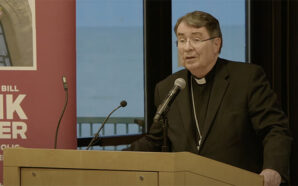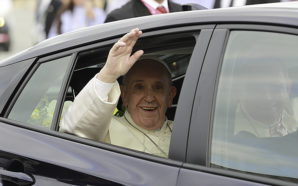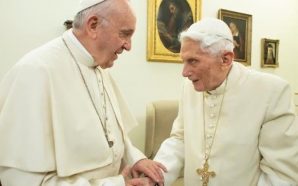My first mission as a Dominican sister was in a rural area of the central Andes, where the majority spoke Quechua, the language of my grandparents. It’s one of nearly 50 languages spoken in Peru, where I was born and raised. Four other Dominican sisters and I were responsible for the administration of a parish that included 29 small villages. There was no resident priest in the area.
Since 2000, Dominican sisters have been representing “the official church” in these villages. The sisters were commissioned by the Archdiocese of Huancayo to baptize, celebrate the Liturgy of the Word with Communion, conduct funerals, witness weddings, accompany the sick, form lay leaders and evangelize. During my three years there, the archbishop visited two or three small villages every year. Once in a while, a priest was available to visit our parish. Therefore, most of the villages had Eucharist and reconciliation just once every year.
Why are these details important? Because I come from an urban context, having grown up in La Oroya, Peru. By coming into contact with the people from a culture different from mine, whose lifestyle was different, I learned about inculturation. I learned that the church does not look the same in every place. It does not have to.
I learned that evangelization is not a one-way process. Rather, it involves “mutual enrichment.” I matured in my faith during the three years I served in that mission.
The people in these small villages have a deep connection with the land. Their livelihood, the means for their children’s education and medical treatments and the existence of livestock depend on the products of the earth. Rain is sometimes a blessing. Other times it causes deadly landslides.
I witnessed the faith of the people who prayed for God’s providential care every morning. The people of the rural communities in the central Andes as well as indigenous people of the Amazon maintain a deep relationship and care for creation that many of us who live in urbanized, industrial and technological nations have lost.
In contrast to indigenous people, multinational companies from urbanized, industrial and technological nations devastate the land, rivers and air in the Andes and in the Amazon. Their extractive activity and greed are bringing to the region new diseases, deforestation and human trafficking.
The people are experiencing a socio-environmental crisis and displacement of indigenous nations. Before these multinational companies arrived, indigenous nations — Catholics and non-Catholics alike — had a lifestyle that preserved creation.
The catastrophic situation in the Amazon is what prompted missionaries living in those areas (bishops, clergy, members of religious congregations and lay missionaries) to call for a synod. Pope Francis heard their cry and called a Synod for the Amazon, which was held in Rome last October. The synod included the input of Catholics from nine countries sharing the Pan-Amazonian region (Peru, Ecuador, Colombia, Venezuela, Guyana and French Guyana, Surinam, Brazil and Bolivia).
In recent years, missionaries, lay leaders of indigenous nations and non-Catholic social leaders have been killed defending the rights of indigenous nations and of ecosystems. One purpose of the synod was to find ways to more effectively reflect the presence of God in those areas where life is threatened.
A key question of the synod was, “How do we want to be a presence of the church and of God there?” Do we transport our way of being Catholics in developed cities to indigenous people? Do we go as the Spaniards of 500 years ago did, carrying the attitude that we have God and they have to learn and accept everything from us? No. The synod calls for a conversion of attitude, a change of heart.
Throughout church history, evangelization has involved an inculturation of the Gospel and implied respect for other cultures. God himself showed us the way. The incarnation is the first major example of inculturation. The son of God was born as a human person within a particular culture.
We often think of Jesus as our savior, king, the second person of the Trinity. But we also profess in our creed that he was a man, and so he was a man of his culture. He was born, grew up and died as a Jew. Consider his encounter with the Syrophoenician woman in Mark 7:24-30 (a Canaanite, according to Matthew 15:21-28), in which he initially refuses to heal her daughter, only to be persuaded by her to change his mind. This unnamed Gentile woman is the hero of the story. Jesus learned from this encounter how he was biased by his own culture and religion.
The origin of our Gospels also provides clear evidence of inculturation. The Gospels were born within different communities and cultures. The author of Mark spoke to a mixed community with the majority being Gentile Christians; the author of Matthew spoke to a majority of Jewish Christians; and the author of Luke spoke to a completely Gentile Christian community. This explains why Jesus in Luke seems more like a Greco-Roman hero, while in Matthew he looks more like Moses.
The writers emphasized some teachings and actions of Jesus according to the needs and lifestyle of the each of their communities. This is what it means to be a member of a universal church. To be one does not mean to be uniform. From the beginning, the church was diverse because the initial leaders were sent to evangelize different communities and cultures. Peter’s communities looked different from Paul’s, and both were different from the Johanine communities.
One of the results of the two-year process of the Synod for the Amazon was the recognition of how God and God’s seeds of salvation are already present in the Amazon region. Indeed, the final document of the synod calls Catholics in the countries of the Pan-Amazonian region to an “integral conversion: a pastoral, cultural, ecological and synodal conversion.”
Because Catholics share the land with non-Catholics, with people from ancestral religions, we do not work in isolation. We are called to walk together being respectful of each other’s religious expressions to defend creation.
Catholics are challenged to be present in the Amazonian region. We do not “bring the Gospel” to the people there. We are called to recognize how the Gospel is already present there and proclaim it. This is what inculturation means today around the globe.
We read in the Second Vatican Council’s decree on missionary activity “Ad Gentes”: “On the one hand, the treasures contained in diverse cultures allow the word of God to produce new fruits and on the other hand, the light of the word allows for a certain selectivity with respect to what cultures have to offer.” The interconnection that indigenous people in the Amazon have with the earth is one of the seeds of the Gospel. All Catholics can learn from them how to live more sustainably, to care for creation, to defend ecosystems.
As Christmas draws near, we reflect on how God is calling us through his incarnation to a deep inculturation of our own here in this land. We do not have to go to the Amazon to encounter other cultures. This is a nation rich in cultural diversity. Will we be able to recognize Jesus, the incarnate Son of God, among Latinos, African Americans, Native Americans, Asian Americans, the neighbors we may not yet know?
My prayer is that we celebrate the seeds of the Gospel spread throughout the many cultures present in the United States, the many ways in which we experience the surpassing truth that God, Emmanuel, is with us.
Sr Mila Díaz Solano OP is a Dominican Sister of Springfield and an assistant professor of biblical studies and homiletics at Mundelein Seminary/University of St. Mary of the Lake. This article was adapted from a talk that Díaz delivered at Archbishop Quigley Center December 10 2019.
With thanks to the Archdiocese of Chicago. Republished with permission.








